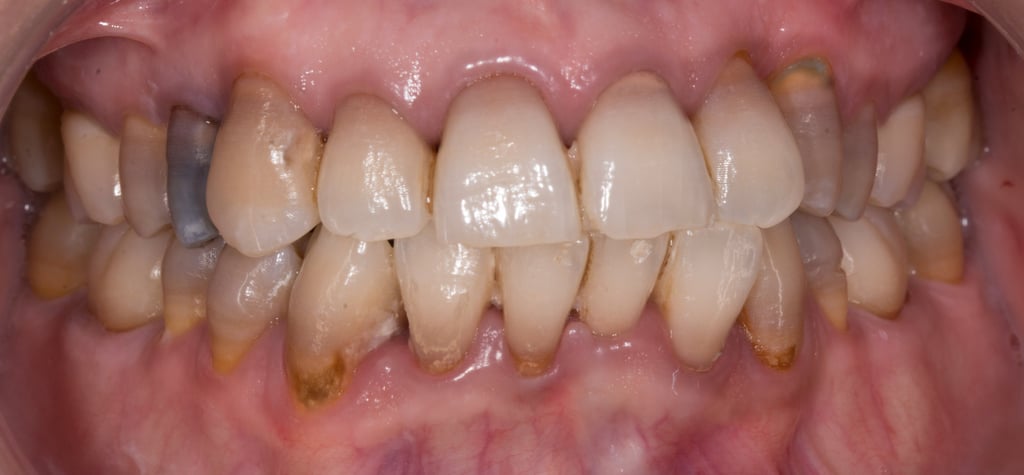Periodontitis... what is that? how to treat it?
Learn more about your gum disease and the possible treatments.
3 min read


Periodontitis, also known as gum disease or pyorrhea, is one of the leading causes of tooth loss in adults. In Italy, it affects about 60% of the population, with 10% developing advanced forms. Despite increasing awareness, many people do not receive a timely diagnosis or appropriate treatment. This condition, often painless in its early stages, can go unnoticed until it is too late to save the teeth.
Causes of Periodontal Disease
The main cause of periodontitis is bacterial plaque, a whitish film that forms on the teeth daily. The bacteria in plaque produce toxins that irritate the gums, causing inflammation (gingivitis). If left untreated, gingivitis can progress to periodontitis, a condition where bacteria gradually destroy the supporting structures of the teeth, forming gum pockets and eventually leading to tooth loss.
Several factors can increase susceptibility to periodontal disease:
Poor oral hygiene
Smoking
Diabetes and other medical conditions
Stress
Genetic predisposition
Symptoms of Periodontitis
The most common signs of gum disease include:
Bleeding gums
Swollen or receding gums
Loose teeth
Persistent bad breath
Tooth sensitivity
It is important to note that not everyone experiences obvious symptoms, which makes regular dental check-ups even more crucial.
How to Treat Periodontitis
The goal of periodontal treatment is to stop the progression of the disease, stabilize the teeth, and improve gum health. In some cases, it is possible to regenerate damaged tissue through specific procedures. Treatment is divided into different phases:
1. Preliminary Phase
This initial phase focuses on two main aspects:
Patient education:
Providing detailed information about the nature of periodontal disease, its causes, and the consequences of leaving it untreated. Effective communication between the clinician and the patient is crucial to motivate the patient to take an active role in their treatment journey.
Identification and modification of risk factors:
Analyzing and addressing factors that can worsen periodontitis, such as:
Inadequate oral hygiene: Teaching proper brushing and flossing techniques to effectively remove bacterial plaque.
Smoking: Tobacco use is a major risk factor; quitting smoking greatly improves periodontal health.
Uncontrolled diabetes: Keeping blood sugar levels under control is essential, as diabetes increases susceptibility to gum infections.
Stress: Managing stress can help improve the body’s ability to fight infections.
2. Non-Surgical Treatment
This initial therapeutic phase aims to reduce inflammation and control infection through:
Oral hygiene instructions:
It is essential to learn proper brushing and flossing techniques to ensure effective removal of plaque and to maintain long-term gum health.
Scaling and root planing (deep cleaning):
This procedure involves removing plaque and tartar from the surfaces of the teeth and the roots beneath the gumline. It helps reduce the depth of periodontal pockets and allows the gums to reattach to the tooth surfaces.
Use of antimicrobial agents:
In some cases, the dentist may recommend antiseptic mouthwashes or localized antibiotic treatments to further reduce bacterial load.
3. Re-evaluation Phase
A few weeks after the non-surgical treatment, a follow-up appointment is scheduled to assess the response of the gums to therapy. At this stage, the dentist evaluates:
Improvement in gum inflammation
Reduction in pocket depth
Patient’s adherence to oral hygiene instructions
If the disease is under control, the patient enters the maintenance phase. If deep pockets persist, surgical treatment may be recommended.
4. Surgical Treatment (if needed)
When non-surgical therapy is not sufficient to restore gum health, surgical intervention may be necessary. These procedures aim to:
Access and clean deeper pockets
Reshape or regenerate lost bone and gum tissue
Stabilize the teeth
Examples include flap surgery, bone grafts, guided tissue regeneration, and soft tissue grafts.
5. Supportive Periodontal Therapy (Maintenance)
Once active treatment is completed, it is essential to maintain the results over time through regular professional cleanings and check-ups, typically every 3–6 months depending on the severity of the case.
This phase helps prevent recurrence of the disease and ensures long-term dental and periodontal health.
Periodontal disease is a serious condition that, if left untreated, can lead to tooth loss and have repercussions on overall health. Prevention and early treatment are essential to avoid irreversible damage. If you suspect you have gum problems, consult your dentist or periodontist for a thorough evaluation.
